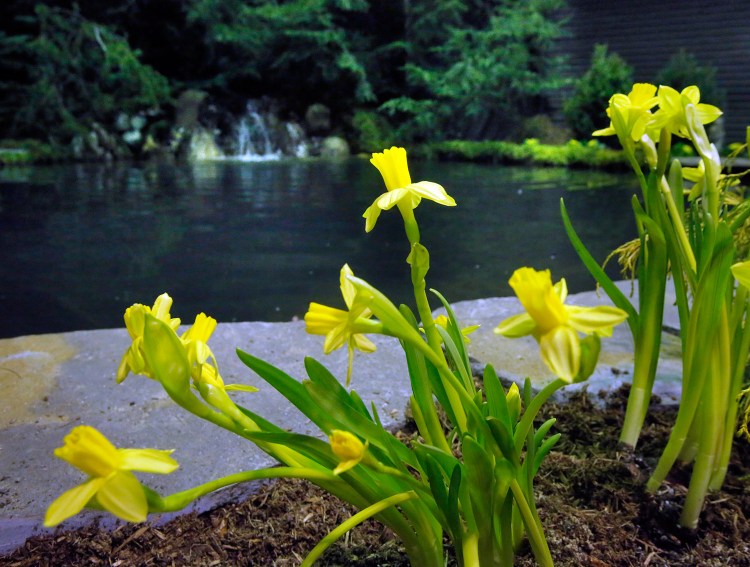The gardening season started late this year. Maine gardening tradition says peas should be planted by Patriots Day so they are ready for Maine’s classic Fourth of July meal – salmon and peas.
Along the coast, the late snows had just barely melted by then and regular rain kept the vegetable garden too soggy to work. Farther inland, the snow hadn’t even melted.
The late start is frustrating because it is going to be a busy year in our garden. We invited my wife Nancy’s cousins and their offspring for a reunion at our house in August, and we want the gardens to look good.
The first step is the back lawn, which for the past few years has included more violets than turf grass. The lawn isn’t large, basically a wide path between the flower beds that takes 15 minutes to mow every three weeks – once the violets stop blooming. We want to keep the violets but include more grass.
My plan is to hand-till the bare spots without disturbing existing grass tufts and plant a hardy, fescue-dominant seed. The violets grow even where the grass is decent, so I won’t be harming them.
Last year, we discovered that our back border garden is now mostly green in August. We have many different kinds of spring-blooming azaleas, rhododendrons and magnolias there, along with some interesting evergreens, but by August it’s dull. We will be scouring the nurseries for native, summer-blooming, shade-tolerant specimens. That part of this renovation should be fun.
Growing good garlic is another goal. After last season’s disappointing crop, I planted four different varieties – rocambole, porcelain, marbled purple stripe and a soft neck – as an experiment. There was still ice in the ground in mid-April when I removed the pine needles I’d used to mulch the garlic. I found a few sprouts, so the plants are healthy, but not much else is happening.
I have a few plans for the vegetable garden – mostly involving peppers and onions. We finally used the last of the peppers that Nancy cut up and froze after a bountiful crop three years ago and when we ran out, we couldn’t find frozen cut peppers in any of the three grocery stores we use. We were then forced to buy imported fresh peppers, which we don’t like to do. We’ve had fresh peppers for grilling and salads in recent summers, but not enough extra to freeze. So I will plant a lot of peppers this year and nurture them carefully.
For the past few years, Nancy has been envious of a friend’s softball-sized onions. Our onions are tasty and store all winter, but are usually small, about the size of golf balls. This year, we have ordered seedling plants of some onion types that grow larger – Ailsa Craig and Copra – but don’t store as well.
We also will be testing Amish snap peas, which Fedco is offering for the first time. This variety, which grows on vines reaching five to six feet, pre-dates the Sugar Snap that has become the standard for tall, edible-pod peas. The catalog says the Amish pea produces earlier than other varieties and has the good, sweet flavor that only comes on tall vines. Because snap peas are a summer staple on our table, we will grow some of the traditional Sugar Snaps, too, just in case the Amish variety doesn’t please us.
This will be the third year for our new(ish) bed of Sparkle strawberries, so this should be the year they produce most heavily. We are looking for a bounty of fresh fruit from late June through early July, and we hope to beat the squirrels to the ripe berries. Shortly thereafter, I will till in the strawberry bed that has served us for almost a decade. I might add a new row of strawberries next year.

Maine Gardener columnist Tom Atwell hopes to keep the birds and rodents far from his blueberries this year. Shawn Patrick Ouellette/Staff Photographer
To scare the birds and rodents away from the blueberries, we plan to put up sparkly and spinning items. If those don’t do the trick, we will put up netting. Netting makes it harder to pick the berries, but this year we are determined to have enough blueberries to count as a crop.
By the time this column appears in print, I hope to be out in the yard, enjoying the warmth and colors of spring. I like snow – for skiing, sledding, aesthetics, and the way it protects the living plants and animals in the soil.
But my continued mental health now requires an extended period of warm, sunny days working with seeds and plants.
Tom Atwell is a freelance writer gardening in Cape Elizabeth. He can be contacted at: tomatwell@me.com
Send questions/comments to the editors.


